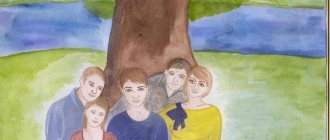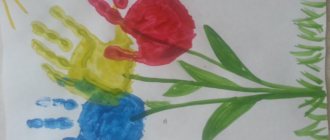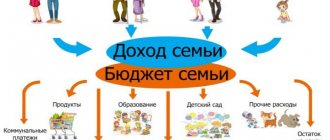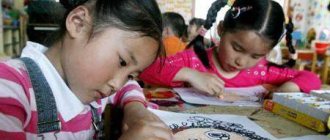Family. All materials on the topic of family - Project for the preparatory group “My Family”
Publication “Project for the preparatory group “My...” Project “My Family” Prepared by: Chereneva O.P. teacher of the highest category Type of project: short-term, creative and informational. Project participants: children of the preparatory group, parents of students, teacher. Relevance: The role of the family in a child’s life is immeasurably great...
Image library "MAAM-pictures"
Summary of an open speech therapy lesson using ICT “Family” Goal: to expand children’s knowledge about the family and its importance in human life. Objectives: - develop visual attention, thinking, memory; - develop gross motor skills, fine motor skills of the fingers; coordination of speech and movements, - to expand and systematize ideas about the family, members...
Summary of educational activities in a multi-age group of compensatory orientation with children with special needs “My Family” Preliminary work: - Conversations with children in everyday life about the family, the activities of family members. - Looking at family albums. — Reading: V. Mayakovsky “Who to be?”, J. Rodari “What do crafts smell like?” — Learning proverbs and sayings about family. — Homework: joint with...
Lesson summary for high school students “Family and Marriage” Lesson summary for high school students “Family and Marriage” Prepared by the orphanage teacher: Olga Vyacheslavovna Kirillova. “Family and Marriage” Purpose: to present to students the general model of the family, briefly revealing each subsection of the topic: responsibility in the family, rights and...
Card index of didactic games on the topic “My Family” card index (senior group)
"Our friendly family"
Goal: Name family members, understand and use generalizing words “family” in active speech.
Material: beautifully decorated box; finger theater, cut out to show finger performances.
Progress of the game:
Open a photo album and invite your child to look at a family photo. Ask him a question, pointing in turn to the image of each family member: “who is this?”
Ask the child what the name of his mother, father, grandmother, grandfather, etc. is. Invite him to tell him what kind of mother he is? (kind, beautiful, good). What kind of dad (tall, strict, handsome). What grandmother? (old, kind).
Place a beautifully decorated box in front of your child and invite him to see what is hidden in it. (Carved heroes of the finger theater). Invite your child to play with the heroes of the finger theater.
This finger is grandpa, (bend your thumb)
This finger is grandma, (bend your index finger)
This finger is daddy, (bend your middle finger)
This finger is mommy, (bend your ring finger)
This finger is me, (bend your little finger)
This is my whole family! (rotate your hands with your fingers apart)
At the end of the game, praise the child, saying that his family is really very friendly.
“Who is hiding behind the door” (riddles)
- He didn't work out of boredom,
His hands are calloused
And now he is old and gray-
My dear, beloved...grandfather.
- Who never gets tired of loving
pies for baking,
Delicious pancakes?
This is our... grandmother
- Who is the cutest in the world?
Who do children love very much?
I’ll answer the question directly:
- Our mother is the sweetest of all...
- The photo is worth
In a gilded frame,
Whose gaze warms the sun?
The look of your beloved...mother
- Who is not joking, but seriously
Will he teach us how to hammer a nail?
Who will teach you to be brave?
If you fall off a bike, don’t you whine?
And scratched my knee,
Don't cry? Of course...dad
- I'm not alone with my mother,
She also has a son
I'm too small next to him,
For me he is a big brother...
Objectives: improve children’s ability to solve riddles; enrich children's vocabulary on the topic “Family”.
Game progress No. 1: the teacher asks a riddle, the child names the answer and, opening the windows on the canvas, looks for the corresponding picture, answering why he chose it.
Game progress No. 2: the child selects the desired picture, explaining his choice, and places it in the desired window on the canvas.
"Guess who I'm talking about."
Objectives: to activate words denoting family members in children’s speech;
improve children’s ability to select definitions that characterize family members, answering the questions posed (Which one? Which one?).
Game progress No. 1: the teacher opens a window and offers:
1. Using the color image, guess and correctly name a family member (mom, dad, grandmother, grandfather, brother, sister, etc.), explain by what features you guessed.
2. Select definitions: which, which (caring, kind, hardworking, gentle, affectionate or hard-working, strong, brave, loved, caring).
3. Tell what kind of work he does around the house.
Game progress No. 2: the teacher (other children) lists definitions that characterize family members, and the child must guess who it is and open the required window.
- Beloved, caring, gentle - mother;
- Kind, affectionate, sweet - grandmother;
- Younger, restless, pugnacious - brother;
- Serious, strong, hardworking - dad;
- Cheerful, smart, beautiful, diligent - sister;
- Kind, serious, smart - grandfather.
Didactic game “My family is the most...”
Objectives: to replenish children’s vocabulary with definitions that characterize family;
continue to teach children to carry out analytical and synthesizing work.
Progress of the game: children take turns laying out pictures on the canvas, conventionally indicating members of their family and answering the questions: -What kind of family do you have?
-My family is the most fun (friendly, hardworking, reading, loves to travel, sports), because...
“Open the window I’ll name.”
Goal: to consolidate ordinal counting, to consolidate the ability to navigate in a small space.
Appendix No. 2
Solving problem situations using didactic canvas.
- Who is related to whom in the family?
- Who does what around the house?
- Who is older, who is younger and why?
- Responsibilities of men and women in the family?
- What can a mother (father), grandmother (grandfather), daughter (son) do around the house and why?
- Who in the family can we call elderly and young people and why?
- Who is more important in the family, mom or dad and why?
- What is family?
- What does friendship mean, love for loved ones, home.
- Who is your dad's grandmother?
- Who is your dad's grandfather?
- Who are your dad's grandparents?
Game rules.
- Act on the teacher’s signal;
- observe sequence, restraint;
- Maintain partnerships by working in pairs.
Didactic game "Who lives in the apartment."
Objectives: to activate words denoting family members in children’s speech; learn to answer questions in complete sentences.
Progress of the game: children match the contour images of family members with color images that conventionally designate family members.
Question: - Explain why you think so?
Didactic game “Make a family from pictures conventionally depicting family members and tell about it.”
Objectives: to improve children’s ability to compose a plot story according to a plan (algorithm, mnemonics);
intensify the use of words and actions in children’s speech on the topic “Family”: the baby is growing, developing; teenager - growing, learning; young man (girl) – growing up, studying, working; adults: father (mother), uncle (aunt) - work, raise children; elderly people (grandfather, grandmother, old woman, grandfather) - help take care of their grandchildren.
Strengthen children's ability to coordinate the endings of adjectives with nouns.
Game progress No. 1: Different generations of the family are laid out on the canvas in the windows.
— At every stage of a person’s life, different changes occur, name them. The child needs to be told who it is and why.
- The baby grows, develops;
- Teenager - growing, learning;
- Boy (girl) - growing up, studying, working;
- Dad (mom), uncle (aunt) - work, raise children;
- Elderly people (grandfather, grandmother, old woman, grandfather) help take care of their grandchildren.
MAGAZINE Preschooler.RF
Goal: To form children’s ideas about themselves, their name, appearance, family members; children in the group. Objectives: 1. Creating a positive emotional mood in the group. 2. Introduce the concepts of “family”, “parents”, “children”. 3. Formation of a simple uncommon sentence with demonstrative words “Here”, “Here”. 4. Development of speech breathing, articulatory motor skills, auditory attention, sense of rhythm. 5. Development of fine, general motor skills, coordination of movements.Equipment: story picture “Family”; dolls - boy, mother, father, grandfather, grandmother, girl (pictures depicting family members); wooden house; toy cow, steam locomotive; a picture depicting the sound symbol U; performing articulatory gymnastics; multi-colored paper flowers. Progress of the lesson. I Organizational moment. The speech therapist greets parents and children by clapping their hands (hello). A boy is heard crying (a doll appears - a boy): UUUUU (loud). II Main part 1. Introduction to the topic. - Hello, boy! (the doll “says hello”) - Let’s say hello to the boy! (clapping) - What's your name? (Petya) - Why are you crying, Petya? - I left my yard for a walk and got lost (uuuuuu... - quietly). - Don't be upset! The guys and I will help you find your home and family. - Shall we help, guys? - Let's get acquainted! (“greets” each child, “giving” his hand, and introduces himself: “Hello! I’m Petya. What’s your name?”) 2. Work on the topic. a) A trip to Petya: - What will we use to look for Petya’s house? By train (the speech therapist shows a picture of a train). - Let’s stand like a train, one after another, and hit the road to look for Petya’s house (adults – “locomotive”, children – “carriages”). - Let's sound like a steam locomotive: U - U - U (loudly and for a long time); tu-tu... (children and their parents stand up, holding each other, moving in a circle to the music): Here is our train, the wheels are knocking. And on our train the guys are sitting, “Tu-tu-tu, tu-tu-tu” - the locomotive is buzzing, Far, far away he took the guys. Here's the stop. Who wants to get down - Come on, guys, Let's go for a walk. Or: The locomotive is going, going - TU - TUUUU. He brought the trailers - TU - TUUUU. — The train stops. Let's go out for a walk! b) Breathing exercises “Flowers”: - Here is the clearing. How many flowers there are in the meadow! (paper flowers are laid out on the floor) - Let's pick them, smell how they smell (children with their parents “collect” the flowers, inhale through their noses and as they exhale say: AAH). - Oh, who is this? (a toy cow or a picture of a cow is “grazing” in a clearing) c) Exercise on onomatopoeia. - A cow mooes in the meadow: “Moo-oo-moo-moo-milk to whom?” - Hello, cow! What is your name? (Burenka) - Guys, how did the cow moo? Burenka, we are looking for Petya’s house, tell us the way. 3. Articulation gymnastics. - Play with me first, then I’ll show you! a) “The cow is chewing grass” (chewing movements); b) “Tongue Walk”: - The tongue sits in the house, came out of the house, basks in the sun, hides in the house again (or: looked to the right (to the side) - to the left (to the other side); c) “Burenka”: Mouth wider open it, play Burenka: let’s open our mouth wide, like a hungry Burenka. You can’t close it, I’m counting until five. And then we’ll close our mouths: Burenka is resting. - Well done, you know how to play with your tongues. - Drive straight and you will see Petya’s house (the children move further like a train: tu - tu - y - y). 4. Conversation on the topic “Family”. - Hooray! This is my home! (there is a toy house on the table) - Guys, come and visit me! (near the house there are dolls - mom, dad, girl, grandfather, grandmother) - Petya, introduce us to your family! - This is my family. My family is big and friendly. Here is dad, mom, grandma, grandpa, sister. 5. Meet Petya’s family. - Mom, dad are my parents (Or: Here is dad. Here is mom). - This is my sister. Her name is Tanya. Tanya and I are children. I am a son, Tanya is a daughter. - I am small. Dad is big. Tanya is small, mom is big. - This is deda (grandfather). This is baba (grandmother). - Tanya and I are their grandchildren. 6. Finger gymnastics “My Family”. — I want to tell you about my family with my fingers (Petya points). - Let's talk about the family together (Petya suggests): This finger is grandfather (grandfather), this finger is baba (grandmother). This finger is dad, this finger is mom. This finger is me. That's my whole family! 7. “Slam the words!” - Now, together with Petya, let’s clap our hands, let’s say who is in his family (the speech therapist shows dolls - family members). 8. Farewell to Petya. - Thank you guys, you helped find my family. Goodbye! (clap) - It's time for us guys to go home. Get up like a train one after another, let's go! (children “ride” to the words of the verse - I): ... Here is the stop. If anyone wants to get down, it’s time to rest, guys! - So we returned home. III Summary of the lesson. - Who came? —What did you drive to see Petya? How did the locomotive sound? (U - U - U; tu - tu - tu) - Who did you see in the clearing? (or: Who mooed? (show)) How did the cow moo? - Who lives in Petya’s family? (father, mother, Tata (sister), grandfather, grandmother)
| Next > |



